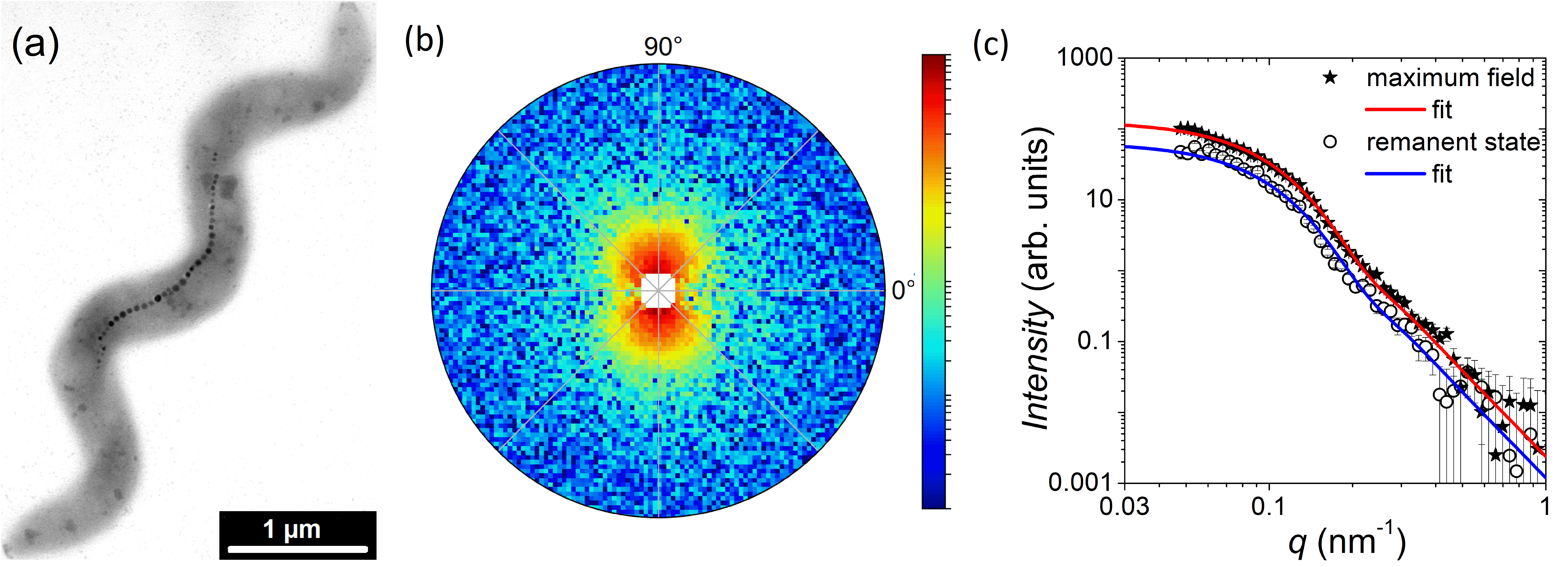The group studied the magnetotactic bacteria Magnetospirillum gryphiswaldense under a strong magnetic field. They found that, even under these conditions, the internal nano-compasses synthesised by the bacteria, and the surrounding scaffolding structure, remains stable.

Figure: (a) Electron microscopy image of the bacteria with a chain of around 30 magnetic nanoparticles. The nanoparticle chain results in a permanent magnetic moment along the chain axis which serves as a nano-compass. (b) 2D SANS pattern of the powder sample of freeze-dried bacteria at zero magnetic field measured at Larmor. (c) 1D data reduced from the 2D patterns at zero field (remanent state) and at 1 T (maximum field). Data analysis shows that the particle moments align in field direction by internal rotation, meaning that the particles itself do not rotate and that the chain structure remains intact also after application of the maximum magnetic field.
Magnetotactic bacteria are aquatic micro-organisms widespread in fresh water. They produce minerals that form a chain of nano-sized magnetic particles inside themselves. These act as a “nano-compass", enabling them to align with the Earth's magnetic field and travel to areas where oxygenated water meets oxygen-deficient water to satisfy their nutritional requirements.
Being able to recreate such one-dimensional nano-compasses is of fundamental scientific interest and could also be useful for applications in areas such as micromechanical sensors. The high level of biological control seen in these bacteria creates chains with much more accuracy than other synthetic techniques and has therefore attracted a lot of interest. However, it has been observed that applying small magnetic fields to immobilised bacteria can cause the particle chains to dissemble.
This study investigated the effect of larger magnetic fields on freeze-dried magnetotactic bacteria M. gryphiswaldense. Using polarized small angle neutron scattering (SANS) on Larmor alongside DC magnetometry enabled the group to determine the properties of the individual magnetic nanoparticles, and the nanostructure and mechanical stability of the chains they form.
They found that each nanoparticle in the chain acts as a single domain, rather than as a complete unit. The internal microstructure was even maintained on application of magnetic fields up to 1 T, proving that freeze-dried bacteria are more robust than expected and can serve as a model for one-dimensional nano-compasses.
Their results have been published in an article that has been chosen as part of Nanoscale Advances' HOT Article Collection.
Dr Philipp Bender from the University of Luxembourg, lead author of the study, explains: “Only thanks to magnetic SANS could we obtain unique insight into the magnetic and chemical structure of these bacteria, and thus prove that they are mechanically stable also in presence of high magnetic fields. This makes them ideal candidates for various envisioned applications of 1D magnetic nanostructures, such as sensors or magnonic devices. For this study Larmor was the ideal instrument as it allowed us to perform polarized SANS over a large size range."
Dr Diego Alba Venero, ISIS instrument scientist, adds; “SANS is a technique tailored for studying inhomogeneities at the nanoscale. For this experiment, Larmor polarised the incoming beam which allowed to observe the magnetic contribution from the magnetosomes over the dominating structural contribution."
Further information
The full paper can be found online at DOI: 10.1039/C9NA00434C
